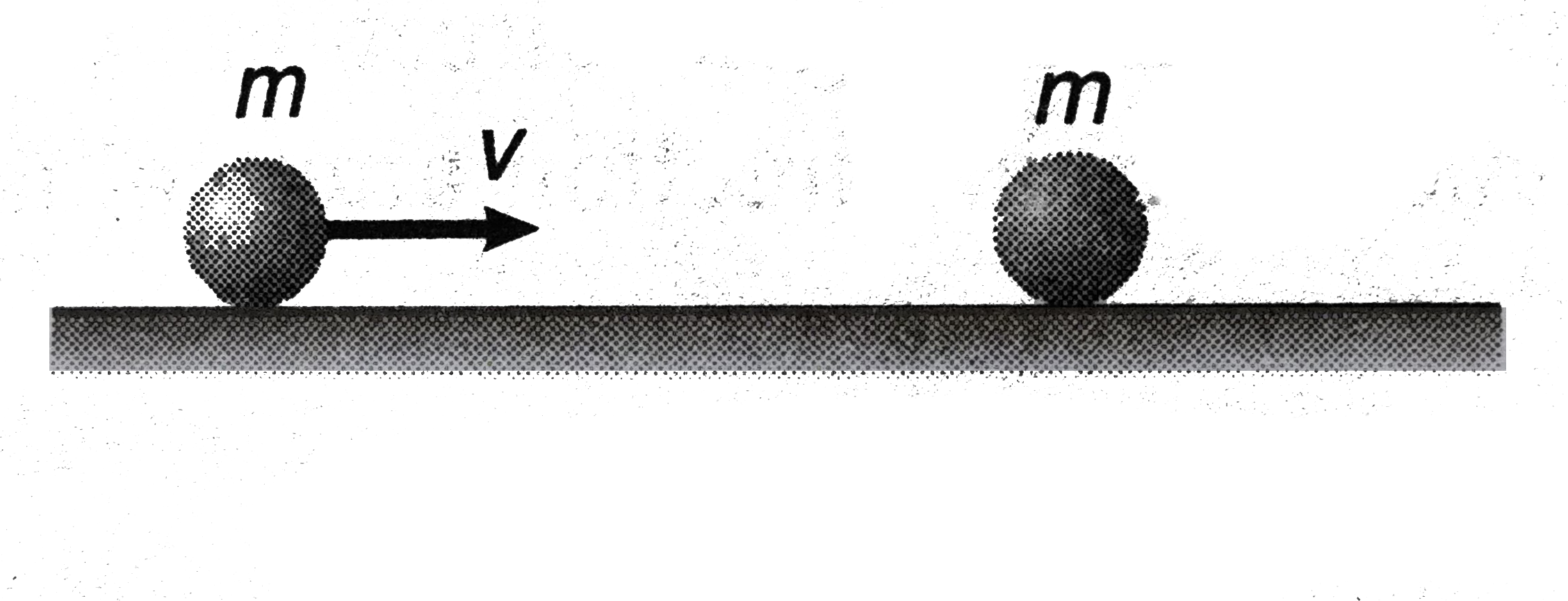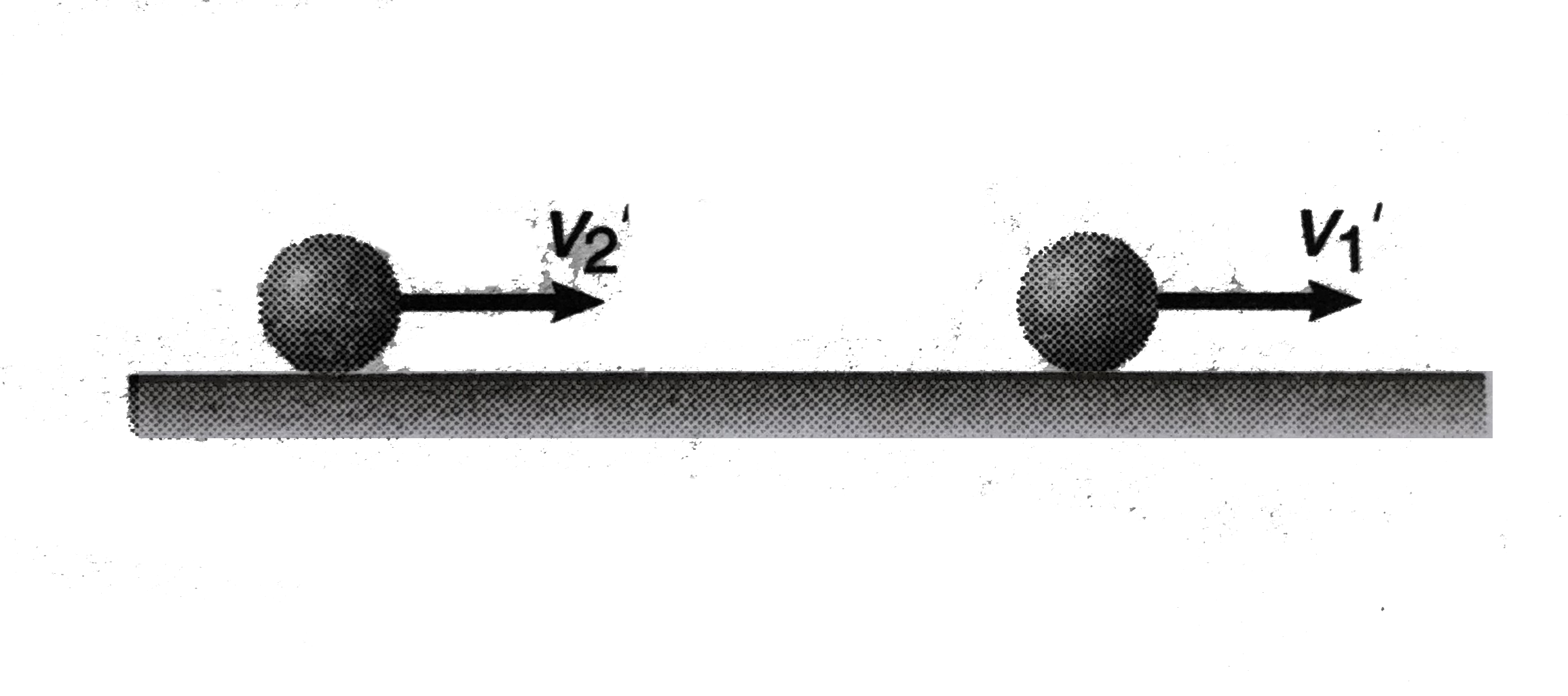A body of mass M moving with a speed u has a ‘head on’, perfectly elastic collision with a body of mass m initially at rest. If M>>m , the speed of the body of mass m after collision, will be nearly :
um/M
uM/m
u/2
2u
The correct Answer is:D
To solve the problem of a perfectly elastic collision between two bodies, we will use the principles of conservation of momentum and conservation of kinetic energy.
1. Identify the given values:
- Mass of body 1 (moving): M
- Initial speed of body 1: u
- Mass of body 2 (initially at rest): m
- Initial speed of body 2: 0
2. Apply the conservation of momentum:
The total momentum before the collision is equal to the total momentum after the collision.
Mu+0=MV1+mV2
where V1 is the final velocity of mass M and V2 is the final velocity of mass m.
3. Apply the conservation of kinetic energy:
Since the collision is perfectly elastic, the total kinetic energy before the collision is equal to the total kinetic energy after the collision.
12Mu2=12MV21+12mV22
4. Rearranging the momentum equation:
From the momentum equation, we can express V1:
Mu=MV1+mV2⟹MV1=Mu−mV2⟹V1=Mu−mV2M
5. Substituting V1 in the kinetic energy equation:
Substitute V1 into the kinetic energy equation:
Mu2=MV21+mV22
Substitute V1:
Mu2=M(Mu−mV2M)2+mV22
6. Simplifying the equation:
This will lead to a complex equation, but we can simplify by considering the case where M≫m. In this case, V1 becomes very small compared to V2.
7. Using the elastic collision formula:
For perfectly elastic collisions, we also have:
V2−V1=u
Rearranging gives:
V1=V2−u
8. Substituting V1 back:
Substitute this back into the momentum equation:
Mu=M(V2−u)+mV2
Rearranging gives:
Mu=MV2−Mu+mV2⟹Mu+Mu=MV2+mV2
2Mu=V2(M+m)⟹V2=2MuM+m
9. Considering M≫m:
Since M is much larger than m, we can approximate:
V2≈2MuM=2u
Final Result:
Thus, the speed of the body of mass m after the collision will be nearly 2u.
- Mass of body 1 (moving): M
- Initial speed of body 1: u
- Mass of body 2 (initially at rest): m
- Initial speed of body 2: 0
The total momentum before the collision is equal to the total momentum after the collision.
Mu+0=MV1+mV2
where V1 is the final velocity of mass M and V2 is the final velocity of mass m.
Since the collision is perfectly elastic, the total kinetic energy before the collision is equal to the total kinetic energy after the collision.
12Mu2=12MV21+12mV22
From the momentum equation, we can express V1:
Mu=MV1+mV2⟹MV1=Mu−mV2⟹V1=Mu−mV2M
Substitute V1 into the kinetic energy equation:
Mu2=MV21+mV22
Substitute V1:
Mu2=M(Mu−mV2M)2+mV22
This will lead to a complex equation, but we can simplify by considering the case where M≫m. In this case, V1 becomes very small compared to V2.
For perfectly elastic collisions, we also have:
V2−V1=u
Rearranging gives:
V1=V2−u
Substitute this back into the momentum equation:
Mu=M(V2−u)+mV2
Rearranging gives:
Mu=MV2−Mu+mV2⟹Mu+Mu=MV2+mV2
2Mu=V2(M+m)⟹V2=2MuM+m
Since M is much larger than m, we can approximate:
V2≈2MuM=2u
Thus, the speed of the body of mass m after the collision will be nearly 2u.
Topper's Solved these Questions
- ENERGY & MOMENTUMBOOK - VMC MODULES ENGLISHCHAPTER - ENERGY & MOMENTUMEXERCISE - Level - 1 PARAGRAPH QUESTIONS
3 Videos
- ENERGY & MOMENTUMBOOK - VMC MODULES ENGLISHCHAPTER - ENERGY & MOMENTUMEXERCISE - LEVEL - 2
48 Videos
- ENERGY & MOMENTUMBOOK - VMC MODULES ENGLISHCHAPTER - ENERGY & MOMENTUMEXERCISE - LEVEL - 0 - LONG ANSWER TYPE
5 Videos
- ELECTROSTATICSBOOK - VMC MODULES ENGLISHCHAPTER - ELECTROSTATICSEXERCISE - JEE Advanced (Archive)
89 Videos
- GASEOUS STATE & THERMODYNAMICSBOOK - VMC MODULES ENGLISHCHAPTER - GASEOUS STATE & THERMODYNAMICSEXERCISE - JEE ADVANCED (ARCHIVE )
111 Videos
Similar Questions
A body of mass m1 moving at a constant speed undergoes an elastic head on collision with a body of mass m2 initially at rest. The ratio of the kinetic energy of mass m1 after the collision to that before the collision is -
View SolutionA body of mass 2 m moving with velocity v makes a head - on elastic collision with another body of mass m which is initially at rest. Loss of kinetic energy of the colliding body (mass 2 m) is
View SolutionIn a head on elastic collision of two bodies of equal masses
View SolutionA ball of mass 'm' moving with speed 'u' undergoes a head-on elastic collision with a ball of mass 'nm' initially at rest. Find the fraction of the incident energy transferred to the second ball.
View SolutionA moving body of mass m makes a head on elastic collision with another body of mass 2m which is initially at rest. Find the fraction of kinetic energy lost by the colliding particles after collision.
View SolutionA moving particle of mass m makes a head-on perfectly inelastic collision with a particle of mas 2m which is initially at rest. Find the fractional loss in energy of the colliding partic le after collision.
View SolutionA body of mass m moving with velocity v collides head on with another body of mass 2m which is initially at rest. The ratio of K.E. of colliding body before and after collision will be
View SolutionA ball of mass m moving at a speed v makes a head on inelastic collision with an identical ball at rest. The kinetic energy of the balls after the collision is 34th of the original. Find the coefficient of restitution.


View SolutionA particle of mass m moving with speed u collides perfectly inelastically with another particle of mass 3 m at rest. Loss of KE of system in the collision is
View SolutionStatement I: If a sphere of mass mmoving with speed u undergoes a perfectly elastic head-on collision with another sphere of heavier mass M at rest (M>m), then direction of velocity of sphere of mass m is reversed due to collision (no external force acts on system of two spheres).
Statement II: During a collision of spheres of unequal masses, the heavier mass exerts more force on the lighter mass in comparison to the force which lighter mass exerts on the heavier one,
View Solution
